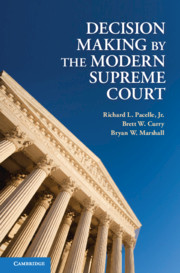Book contents
- Frontmatter
- Contents
- Acknowledgments
- 1 The Supreme Court
- 2 Heuristic Models of Judicial Decision Making
- 3 Building an Integrated Model of Decision Making
- 4 Decision Making on the Modern Supreme Court
- 5 Building a New Legacy
- 6 Sharing the Protection of Minorities
- 7 Avoiding Another Self-Inflicted Wound
- 8 Policing the Boundaries
- 9 Conclusion
- Measurement Appendix
- Cases Cited
- References
- Index
4 - Decision Making on the Modern Supreme Court
Examining the Influences
Published online by Cambridge University Press: 05 June 2012
- Frontmatter
- Contents
- Acknowledgments
- 1 The Supreme Court
- 2 Heuristic Models of Judicial Decision Making
- 3 Building an Integrated Model of Decision Making
- 4 Decision Making on the Modern Supreme Court
- 5 Building a New Legacy
- 6 Sharing the Protection of Minorities
- 7 Avoiding Another Self-Inflicted Wound
- 8 Policing the Boundaries
- 9 Conclusion
- Measurement Appendix
- Cases Cited
- References
- Index
Summary
We started this project with a number of research questions. Despite the lure of the siren song of the attitudinal model, we were not seduced. Theories that are simple and elegant are openly embraced in the social and physical sciences. Yet reality is seldom simple and almost never easily compartmentalized. Sure policy predilections are important and likely the most compelling factor in explaining decision making. But are they the only explanation? It strains credulity. We start with this simple question: Is the attitudinal model the only factor that explains Supreme Court decision making? If so, this has important normative consequences. It suggests that the justices are simply legislators in robes who are free to impose their vision of the good society on the law and the public with impunity. They are the essence, then, of the Platonic guardians. And what makes the situation even worse is that the justices hide behind the pomp and circumstance of the institution and the velvet curtain that separates their bench from the public. They pretend to rely on the law, philosophy, neutral principles, and the Constitution, yet all the while they are simply exercising their sincere policy preferences (Segal, Spaeth, and Benesh 2005). Furthermore, they are beyond the reach of the public and cannot be removed from office (except in the case of very bad behavior).
- Type
- Chapter
- Information
- Decision Making by the Modern Supreme Court , pp. 63 - 78Publisher: Cambridge University PressPrint publication year: 2011



